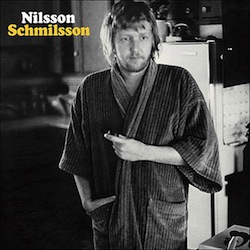Thursday, March 13, 2014
Classic Albums: Harry Nilsson, Nilsson Schmilsson
Harry Nilsson has got to be one of the most unique figures in musical history. He was a great songwriter who made hits for others (as in There Dog Night's version of "One"), yet he was also a fantastic singer with a multi-octive range and the ability to wring the pathos out of a song. That's perhaps why his biggest hit, "Everybody's Talking" was a cover, one his many stellar interpretations of others' compositions. He is also unfortunately known for the squandering of his talent through alcohol and a drunken screaming contest with John Lennon that shredded his vocal cords.
Nilsson put out a lot of good records, but none can really compare to his apex, 1971's Nilsson Schmilsson. It's an album that feels comfortable and homey, a tone set by the cover, showing Nilsson in a bathrobe, and the back, displaying the inside of his fridge. The first song, "Gotta Get Up" is about that most quotidian of tasks, getting up in the morning to get to work. The narrator hurries and hustles to get to his job, but dreams about his lost youth and the good times he had. The next, "Driving Along," continues the theme of observing daily life, and might be this album's secret weapon. Nilsson really reaches the stratosphere with his voice, a moved matched by some great, soaring guitar. It's a reminder that for this album Nilsson had great session musicians and studio magic contributing their best to his songs. The theme of morning continues with the next song, "Early in the Morning," a wonderfully spare cover of the Louis Jordan blues tune, with only a minimalist organ backing Nilsson, allowing his voice to really take over. When I lived in Newark and walked from my apartment to Penn Station down Ferry Street each morning, I loved to listen to this song with the sun barely peaking out over the horizon.
Showing off his impressive versatility, the fourth track, "The Moonbeam Song," is a beautiful ballad complete with strings, languid as a cool June breeze. Suddenly, on the muscular and soulful "Down," the last song on side one, Nilsson shifts into a higher gear. One thing that makes Schmilsson so great is that it never gets stuck in a rut or sticks to a formula. Each song a gem in itself.
Side two opens with the biggest hit on the record, a cover of Badfinger's "Without You." I will admit that it is a little overwrought and overdramatic, but that being said, it has some of Nilsson's best singing. What has always fascinated me about his singing is that he makes it sound so effortless, even while he is belting out the last chorus with such overwhelming force. It is a song obviously intended for the AM radio waves, and while it is not one of my favorite Nilsson tunes, its emotional power seems overwhelming next to tunes like "Love Grows Where My Rosemary Goes." And then, like some kind of mad scientist, he moves on to "Coconut," a silly, catchy number with Caribbean overtones, as if we were not supposed to take the overblown pathos of "Without You" seriously.
Mirroring the first side (remember, we're talking about LPs here, folks) the third song on side two is another cover, this time of the R&B standard "Let The Good Times Roll." He gives it a kind of laid-back vibe, which makes it sound like something that The Dude in The Big Lebowski would listen to while sipping a white Russian. That mellow feeling disappears on the seven-minute long "Jump Into the Fire," a bona fide rock and roll jam. It starts, incongruously, with a heavy bass line that forms the basis of a great, propulsive groove. (There's a reason Scorsese used this song in the frenzied end to Goodfellas when Henry Hill is coming unraveled.) Interestingly, the instruments matter most here, and Nilsson's voice takes a back seat. It's almost as if after backing him so well elsewhere, that Nilsson wanted to let the studio musicians have a chance to really cut loose.
It's really hard to follow such an extended moment of rocknroll exuberance. The next song, "I'll Never Leave You" dials back the energy in favor of piano, horns, and strings balladeering. The horns are ominously minor-key and discordant, not bright and shiny, the strings plucked instead of soaring. It sounds like a sad circus calliope, with Nilsson singing in a forlorn way, his voice somewhat buried. It is a daringly ominous way to end such a catchy, poppy album and hints at Nilsson's own struggles with the dark side.
Albums rarely come any better than this, and the diversity of styles always keeps getting me to come back. I find Schmilsson to be an especially great album for March, a month with unpredictable weather that jumps all over the place (sometimes in the same day), but with the hope for spring always present underneath it all. This album is the same way, the windy lion of "Jump Into the Fire" giving way to the calm lamb of "The Moonbeam Song."
Subscribe to:
Post Comments (Atom)

No comments:
Post a Comment